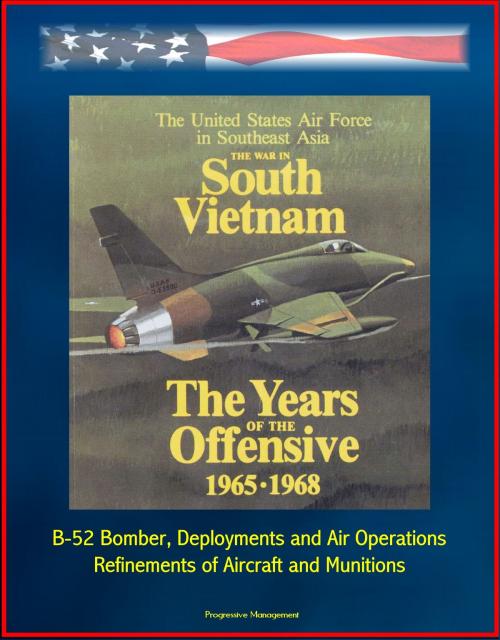The War in South Vietnam: The Years of the Offensive 1965-1968 - The United States Air Force in Southeast Asia - B-52 Bomber, Deployments and Air Operations, Refinements of Aircraft and Munitions
Nonfiction, History, Military, Vietnam War, Asian, Aviation| Author: | Progressive Management | ISBN: | 9781311613578 |
| Publisher: | Progressive Management | Publication: | August 30, 2015 |
| Imprint: | Smashwords Edition | Language: | English |
| Author: | Progressive Management |
| ISBN: | 9781311613578 |
| Publisher: | Progressive Management |
| Publication: | August 30, 2015 |
| Imprint: | Smashwords Edition |
| Language: | English |
Professionally converted for accurate flowing-text e-book format reproduction, this U.S. Air Force (USAF) publication examines the Air Force's support of the ground war in South Vietnam between 1965 and early 1968. The book covers the period from the time when the United States began moving from an advisory role into one of active involvement to just before the time when the United States gradually began disengaging from the war. The final scene is the successful air campaign conducted during the Communists' siege of the Marine camp at Khe Sanh. While the actual siege lasted from late January to the middle of March 1968, enemy preparations for the encirclement—greatly increased truck traffic and enemy troop movements—were seen as early as October 1967. A subsequent volume in the Southeast Asia series will take up the story with the Communists' concurrent Tet offensive during January and February 1968.
Air Force assistance in South Vietnam during the war was principally of two kinds: close air support of troops on the battlefield, by both tactical fighters and B-52s, and the airlift of supplies and personnel. In addition to close air support and airlift, the Air Force performed many other important missions ancillary to the ground war, including reconnaissance, intelligence, psychological warfare, defoliation, destruction of enemy reinforcements and supplies, medical evacuation, and pacification and civic action.
Historically, close air support has occupied a lower priority in the hierarchy of Air Force missions than strategic bombing and interdiction. In theory since the 1930s, and in actuality since World War II, the Air Force has seen itself primarily as the strategic deliverer of destructive force on the industrial and economic heartland of an enemy. Preventing the flow of enemy reinforcements by interdicting them far from the battlefield was also considered an inherently important and effective function of air power. Close air support, for a variety of historical and doctrinal reasons, had been deemed a less fruitful use of air resources. As a consequence, more attention has been paid by historians of the conflict in Southeast Asia to the bombing campaigns against North Vietnam and the interdiction efforts against the Ho Chi Minh Trail in Laos than to the less dramatic but no less important air efforts within South Vietnam. In this volume Col. John Schlight, formerly Deputy Chief of the Office of Air Force History, describes the many issues that were awakened when the Air Force was forced to adapt some of its resources and doctrine to a jungle war in South Vietnam.
Introduction - The Advisory Years, 1955-1964 * I. End of the Advisory Period, November 1964-April 1965 * II. Beginning of Direct Involvement, April-June 1965 * III. U.S. Assumes Major Role, June-September 1965 * IV. Air Force Deployments and Air Operations September-December 1965 * V. Settling In and Sorting Out, January-April 1966 * VI. Setbacks for Centralized Air Power, May-December 1966 * VII. The "Frontier" Spirit, 1966 * VIII. Air Operations, 1966 * IX. Refinements of Aircraft and Munitions, 1967 * X. Air Operations, January 1967-March 1968 * XI. Conclusion
Professionally converted for accurate flowing-text e-book format reproduction, this U.S. Air Force (USAF) publication examines the Air Force's support of the ground war in South Vietnam between 1965 and early 1968. The book covers the period from the time when the United States began moving from an advisory role into one of active involvement to just before the time when the United States gradually began disengaging from the war. The final scene is the successful air campaign conducted during the Communists' siege of the Marine camp at Khe Sanh. While the actual siege lasted from late January to the middle of March 1968, enemy preparations for the encirclement—greatly increased truck traffic and enemy troop movements—were seen as early as October 1967. A subsequent volume in the Southeast Asia series will take up the story with the Communists' concurrent Tet offensive during January and February 1968.
Air Force assistance in South Vietnam during the war was principally of two kinds: close air support of troops on the battlefield, by both tactical fighters and B-52s, and the airlift of supplies and personnel. In addition to close air support and airlift, the Air Force performed many other important missions ancillary to the ground war, including reconnaissance, intelligence, psychological warfare, defoliation, destruction of enemy reinforcements and supplies, medical evacuation, and pacification and civic action.
Historically, close air support has occupied a lower priority in the hierarchy of Air Force missions than strategic bombing and interdiction. In theory since the 1930s, and in actuality since World War II, the Air Force has seen itself primarily as the strategic deliverer of destructive force on the industrial and economic heartland of an enemy. Preventing the flow of enemy reinforcements by interdicting them far from the battlefield was also considered an inherently important and effective function of air power. Close air support, for a variety of historical and doctrinal reasons, had been deemed a less fruitful use of air resources. As a consequence, more attention has been paid by historians of the conflict in Southeast Asia to the bombing campaigns against North Vietnam and the interdiction efforts against the Ho Chi Minh Trail in Laos than to the less dramatic but no less important air efforts within South Vietnam. In this volume Col. John Schlight, formerly Deputy Chief of the Office of Air Force History, describes the many issues that were awakened when the Air Force was forced to adapt some of its resources and doctrine to a jungle war in South Vietnam.
Introduction - The Advisory Years, 1955-1964 * I. End of the Advisory Period, November 1964-April 1965 * II. Beginning of Direct Involvement, April-June 1965 * III. U.S. Assumes Major Role, June-September 1965 * IV. Air Force Deployments and Air Operations September-December 1965 * V. Settling In and Sorting Out, January-April 1966 * VI. Setbacks for Centralized Air Power, May-December 1966 * VII. The "Frontier" Spirit, 1966 * VIII. Air Operations, 1966 * IX. Refinements of Aircraft and Munitions, 1967 * X. Air Operations, January 1967-March 1968 * XI. Conclusion















